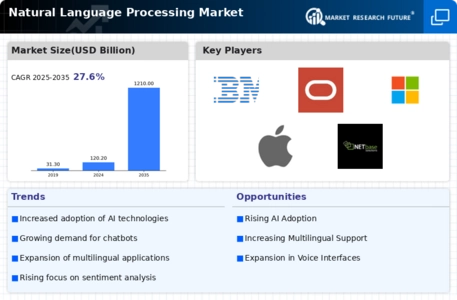Top Industry Leaders in the Natural Language Processing Market

Decoding the Dynamics: A Deep Dive into the Natural Language Processing (NLP) Market Landscape
The Natural Language Processing (NLP) market, where computers decipher and interact with human language, is experiencing explosive growth, projected to reach a staggering value by 2029. This rapid ascent attracts diverse players, all vying for dominance in this burgeoning ecosystem. Understanding the complex interplay of forces shaping this market is crucial for businesses seeking to harness the power of NLP.
Key Players:
- IBM (US)
- Oracle (US)
- Apple (US)
- Microsoft (US)
- HP (US)
- Netbase Solutions (US)
Strategies for Success:
-
Diversification and Integration: Players are expanding beyond core NLP functionalities, offering platforms or ecosystems encompassing data pre-processing, model training, and deployment alongside the NLP engine.
-
Industry-Specific Focus: Tailoring NLP solutions to specific industries like healthcare, finance, or retail allows for deeper customization and caters to distinct user needs.
-
Cloud-Native Solutions: Leveraging cloud infrastructure for scalability, flexibility, and pay-as-you-go models is crucial for wider adoption, especially amongst smaller businesses.
-
Collaboration and Partnerships: Strategic partnerships between big players and smaller specialists foster innovation, accelerate development, and broaden market reach.
Factors for Market Share Analysis:
-
Product Portfolio and Functionality: The breadth and depth of NLP capabilities offered, encompassing tasks like sentiment analysis, text classification, or text generation, significantly impact competitiveness.
-
Ease of Use and Deployment: User-friendly interfaces, comprehensive documentation, and integration with existing tools or platforms are crucial for adoption, especially by non-technical users.
-
Pricing and Licensing Models: Flexible pricing options, subscription models, and free open-source alternatives influence market penetration and accessibility.
-
Security and Compliance: Adherence to strict data privacy regulations and security standards is essential for gaining trust and building robust, ethical NLP solutions.
New and Emerging Companies:
The constant influx of innovative start-ups keeps the NLP market dynamic, introducing niche solutions and challenging established players. Some notable examples include:
-
Afiniti: Specializes in AI-powered customer journey optimization using NLP for personalized engagement and improved customer experience.
-
OpenAI: Develops advanced language models like GPT-3, pushing the boundaries of NLP capabilities in areas like text generation and creative writing.
-
Rasa AI: Offers an open-source framework for building chatbots and conversational AI applications, empowering developers to create custom conversational interfaces.
Current Investment Trends:
Investment in the NLP market is booming, with both established players and venture capitalists recognizing its vast potential. Key areas of focus include:
-
AI and Machine Learning Advances: Continuously improving AI algorithms and machine learning techniques enhance NLP accuracy, efficiency, and capabilities.
-
Domain-Specific NLP Development: Tailoring NLP solutions to specific industries or tasks like medical diagnosis or legal document analysis unlocks new market opportunities.
-
Edge Computing Integration: Embedding NLP capabilities at the edge of networks closer to data sources enables faster processing and real-time decision-making.
-
Ethical NLP and Bias Detection: Addressing concerns about fairness, transparency, and potential bias in NLP algorithms is crucial for building responsible and trustworthy AI.
Latest Company Updates:
-
Dec 20, 2023: VentureBeat: Increased focus on generative AI models like ChatGPT for content creation, translation, and dialogue generation. -
Jan 2, 2024: MIT Technology Review: Advancements in multi-modal NLP enabling AI systems to process and understand information from various sources like text, images, and audio. -
Dec 28, 2023: Forbes: NLP finding applications in customer service chatbots, personalized marketing campaigns, and automated data analysis across various industries.









